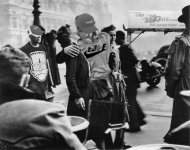sanmich
Veteran
About nostalgia:
http://www.imdb.com/title/tt1605783/
I have a 1967 photo mag, and most of it is total garbage. excessive use of super wides mainly.
The only things that I personally find annoying today and which were different some decades ago is the density of cars, and the uniformization of the human/urban landscape.
Other than that, one can still take breathtakingly good pictures in a black and white rectangle, even if the format is not exactly new.
I do agree that with the easiness of life today, some general atmosphere of sloppiness and lack of serious dedication seem prevalent.
http://www.imdb.com/title/tt1605783/
I have a 1967 photo mag, and most of it is total garbage. excessive use of super wides mainly.
The only things that I personally find annoying today and which were different some decades ago is the density of cars, and the uniformization of the human/urban landscape.
Other than that, one can still take breathtakingly good pictures in a black and white rectangle, even if the format is not exactly new.
I do agree that with the easiness of life today, some general atmosphere of sloppiness and lack of serious dedication seem prevalent.



